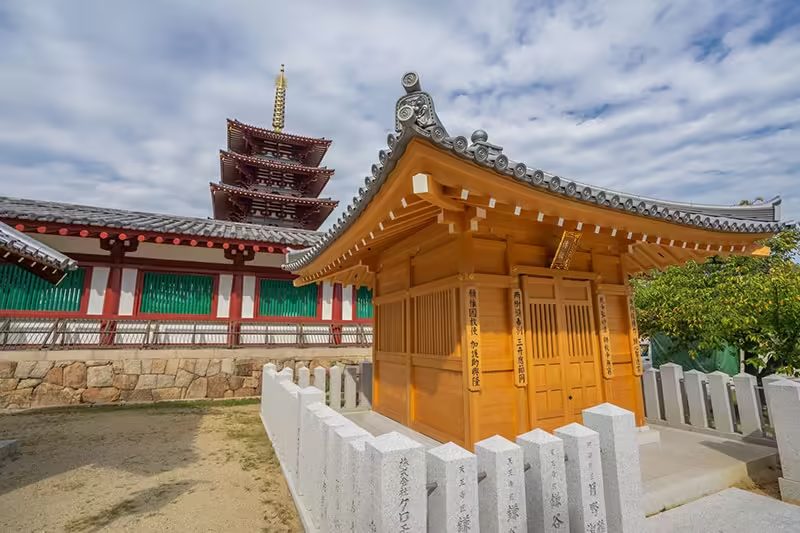前文

593年、聖徳太子(厩戸皇子)は、推古天皇の摂政に就任しました。これは日本の歴史における重要な出来事であり、後の日本の文化と政治体制に大きな影響を与えました。この記事では、聖徳太子の摂政としての役割とその影響、そして関連する聖地を詳しく紹介します。
Introduction
In 593, Prince Shōtoku (Umayado no ōji) became the regent for Empress Suiko. This event was a significant milestone in Japanese history, greatly influencing the cultural and political systems of the country. This article delves into Prince Shōtoku’s role as regent, his impact, and the sacred sites associated with him.
聖徳太子とは?
聖徳太子(574年-622年)は、飛鳥時代に活躍した日本の皇族であり、日本の歴史において極めて重要な人物です。彼は、用明天皇の第二王子として生まれ、幼少期からその聡明さで知られていました。聖徳太子は、多くの伝説と物語に彩られており、彼の影響力は後の日本の政治と文化に深く刻まれています。
Who Was Prince Shōtoku?
Prince Shōtoku (574-622 AD) was a prominent royal figure during the Asuka period in Japan. Born as the second son of Emperor Yōmei, he was known for his intelligence from an early age. Surrounded by many legends and stories, Prince Shōtoku’s influence left a lasting mark on Japanese politics and culture.
仏教の普及者としての聖徳太子
聖徳太子は仏教の熱心な信奉者であり、日本における仏教の普及において中心的な役割を果たしました。彼は、仏教寺院の建立や仏教教義の広範な受容を推進しました。特に、法隆寺や四天王寺などの寺院は、彼の努力の成果として知られています。
As a Promoter of Buddhism
Prince Shōtoku was a fervent advocate of Buddhism and played a central role in its spread throughout Japan. He promoted the establishment of Buddhist temples and the widespread acceptance of Buddhist teachings. Notable examples of his efforts include the construction of Hōryū-ji and Shitennō-ji temples.
摂政としての聖徳太子の役割
593年、聖徳太子は、推古天皇の摂政として日本の政治の中心に立ちました。推古天皇は日本初の女性天皇であり、聖徳太子の指導の下で、多くの政治改革が行われました。彼は、中央集権化の推進や、十七条憲法の制定など、重要な改革を進めました。
Role as Regent
In 593, Prince Shōtoku became the regent for Empress Suiko, Japan’s first female emperor. Under his leadership, significant political reforms were implemented. He pushed for centralization and established the Seventeen-Article Constitution, which outlined the principles for governance and ethics.
十七条憲法の意義
聖徳太子が制定した十七条憲法は、日本最初の成文憲法として知られています。この憲法は、仏教の教えに基づき、国家の統治と倫理的な指針を示しました。特に、和の精神や公正な政治の重要性を強調しており、日本の政治文化に深い影響を与えました。
Significance of the Seventeen-Article Constitution
The Seventeen-Article Constitution, established by Prince Shōtoku, is recognized as Japan’s first written constitution. It was based on Buddhist teachings and provided guidelines for governance and ethical conduct. The constitution emphasized the spirit of harmony and the importance of fair politics, leaving a profound impact on Japan’s political culture.
地政学的な影響
聖徳太子の摂政就任は、日本の地政学的な状況にも影響を与えました。当時の日本は、朝鮮半島や中国との関係が密接であり、これらの国々からの影響を受けながら、独自の文化と政治体制を築いていました。聖徳太子は、隋との外交関係を重視し、文化と技術の交流を進めました。
Geopolitical Influence
Prince Shōtoku’s appointment as regent also affected Japan’s geopolitical landscape. During this period, Japan maintained close relations with the Korean Peninsula and China, adopting and adapting influences from these regions while developing its own culture and political system. Prince Shōtoku placed significant importance on diplomatic relations with the Sui Dynasty, fostering cultural and technological exchanges.
関連する聖地
法隆寺
法隆寺は、聖徳太子が建立したとされる世界最古の木造建築です。この寺院は、彼の仏教信仰の象徴として重要な役割を果たしました。法隆寺は奈良県斑鳩町に位置し、ユネスコの世界遺産にも登録されています。
住所: 奈良県生駒郡斑鳩町法隆寺山内1-1
公式HP: 法隆寺公式サイト
Hōryū-ji Temple
Hōryū-ji Temple, considered the world’s oldest wooden structure, was established by Prince Shōtoku. It played a significant role as a symbol of his Buddhist faith. Located in Ikaruga, Nara Prefecture, Hōryū-ji is also recognized as a UNESCO World Heritage Site.
Address: 1-1 Hōryūji Yamaichi, Ikaruga, Ikoma District, Nara Prefecture
Official Website: Hōryū-ji Official Website
飛鳥寺
飛鳥寺は、聖徳太子が仏教の普及を図るために建立した寺院の一つです。この寺院は、当時の政治と宗教の中心地である飛鳥に位置しています。飛鳥寺は、日本最古の本格的な仏教寺院とされ、その歴史的な価値は計り知れません。
住所: 奈良県高市郡明日香村飛鳥682
Asuka-dera Temple
Asuka-dera Temple is another significant temple established by Prince Shōtoku to promote Buddhism. Located in Asuka, the political and religious center of that time, Asuka-dera is regarded as Japan’s oldest full-scale Buddhist temple, bearing immense historical value.
Address: 682 Asuka, Asuka-mura, Takaichi District, Nara Prefecture
四天王寺

四天王寺は、大阪に位置する聖徳太子によって建立された寺院であり、彼の仏教信仰のもう一つの象徴です。四天王寺は、仏教の四天王を祀っており、その壮大な建築は訪れる人々に深い感銘を与えます。
住所: 大阪府大阪市天王寺区四天王寺1-11-18
公式HP: 四天王寺公式サイト
Shitennō-ji Temple
Shitennō-ji Temple, located in Osaka, is another significant temple founded by Prince Shōtoku. Dedicated to the Four Heavenly Kings, Shitennō-ji stands as a testament to his Buddhist devotion. The temple’s grand architecture leaves a lasting impression on visitors.
Address: 1-11-18 Shitennoji, Tennoji, Osaka, Osaka Prefecture
Official Website: Shitennō-ji Official Website
まとめ
聖徳太子の摂政就任は、日本の歴史において重要な出来事でした。彼の指導により、日本は仏教を受け入れ、中央集権化を進めました。また、法隆寺や飛鳥寺、四天王寺などの寺院は、彼の功績を物語る重要な遺産です。これらの聖地を訪れることで、聖徳太子の時代にタイムスリップし、日本の歴史の深さを感じることができます。
Conclusion
Prince Shōtoku’s appointment as regent was a significant milestone in Japanese history. Under his leadership, Japan embraced Buddhism and moved towards centralization. Temples like Hōryū-ji, Asuka-dera, and Shitennō-ji stand as important legacies of his contributions. Visiting these sacred sites offers a glimpse into the era of Prince Shōtoku and the profound depth of Japanese history.
質問と回答
- 聖徳太子が摂政に就任した年は?
- 答え: 593年
Answer: 593 AD - 法隆寺の所在地はどこですか?
- 答え: 奈良県斑鳩町
Answer: Ikaruga, Nara Prefecture - 四天王寺を建立した人物は誰ですか?
- 答え: 聖徳太子
Answer: Prince Shōtoku


